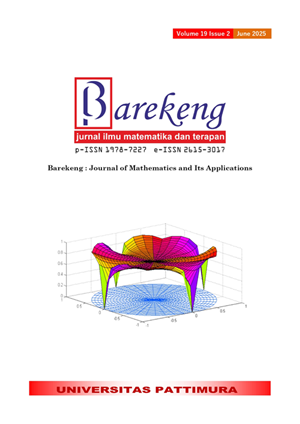GAME THEORY AND MARKOV CHAIN ANALYSIS OF THE DISPLACEMENT OF SHOPPING MALL VISITORS IN SURAKARTA CITY
Abstract
The era of globalization has led to changes in social patterns and lifestyles. With these changes, shopping malls were built to fulfill the community’s needs. This study aims to analyze the displacement of visitors in three shopping malls in Surakarta City, namely Solo Paragon Mall, Solo Grand Mall, and Solo Square, using game theory and the Markov chain. Game theory is used to determine the optimal strategy of each shopping mall based on six indicators of visitor satisfaction, namely product diversity, presence of transportation modes, distance, price, facilities, and services. Saddle points are obtained by pure strategy. The calculation results with the game theory method resulted in three competitions. The first competition between Solo Paragon Mall and Solo Grand Mall obtained the optimal strategy of Solo Paragon Mall is product diversity. At the same time, Solo Grand Mall is the existence of transportation modes. The second competition between Solo Paragon Mall and Solo Square obtained the optimal strategy of Solo Paragon Mall, which is product diversity, while Solo Square's optimal strategy is service. Lastly, the third competition, Solo Grand Mall and Solo Square, obtained the optimal strategy of Solo Grand Mall is the presence of transportation modes and Solo Square is service. Markov chain is used to calculate the transition probability of visitors and steady state, which shows that Solo Paragon Mall is more desirable with a steady state probability of 0.4459, followed by Solo Square 0.3584 and Solo Grand Mall 0.1957. The results of this study can help shopping malls evaluate and improve their strategies to increase loyalty and attract new visitors.
Downloads
References
M. SS, “DETERMINING SHOPPING MALLS CUSTOMERS’ SATISFACTION AND LOYALTY,” J. Bus. Retail Manag. Res., vol. 13, no. 01, pp. 121–130, 2018, doi: 10.24052/jbrmr/v13is01/art-12.
A. F. Primadani and N. Nurhasan, “TIPOLOGI RUANG PUBLIK PUSAT PERBELANJAAN (STUDI KASUS: SOLO GRAND MALL, SOLO PARAGON MALL, DAN SOLO SQUARE),” Sinektika J. Arsit., vol. 17, no. 1, pp. 34–40, 2020, doi: 10.23917/sinektika.v17i1.10851.
V. Bhatt and M. Saiyed, “AN EMPIRICAL STUDY ON BRAND SWITCHING BEHAVIOR OF CONSUMERS IN THE FMCG INDUSTRY W. R.T AHMEDABAD,” Roots Int. J. Multidiscip. Res., vol. Vol.2, no. January, p. No. 2: 128-138, 2018.
S. Bonau, “A CASE FOR BEHAVIOURAL GAME THEORY,” J. Game Theory, vol. 2017, no. 1, pp. 7–14, 2017, doi: 10.5923/j.jgt.20170601.02.
L. Use, “TeMA”.
I. Ananda Ismail, N. Lian Pernadi, and A. Febriyanti, “HOW TO GRAB AND DETERMINE THE SIZE OF THE SAMPLE FOR RESEARCH,” Int. J. Acad. Appl. Res., vol. 6, no. 9, pp. 88–92, 2022, [Online]. Available: www.ijeais.org/ijaar
H. Taherdoost and G. Hamta, “VALIDITY AND RELIABILITY OF THE RESEARCH INSTRUMENT ; HOW TO TEST THE VALIDATION OF A QUESTIONNAIRE / SURVEY IN A RESEARCHFILE:///C:/Users/admin/Desktop/RISACHI REPORT 2021/reference B/2190-8050-1-PB-1 SOCIO.pdf,” Int. J. Sport. Exerc. Train. Sci., vol. 5, no. 3, pp. 27–36, 2017.
P. P. Kuantitatif, “METODE PENELITIAN KUNATITATIF KUALITATIF DAN R&D,” Alf. Bandung, 2016.
O. Bolarinwa, “PRINCIPLES AND METHODS OF VALIDITY AND RELIABILITY TESTING OF QUESTIONNAIRES USED IN SOCIAL AND HEALTH SCIENCE RESEARCHES,” Niger. Postgrad. Med. J., vol. 22, no. 4, p. 195, 2015, doi: 10.4103/1117-1936.173959.
S. O. Ekolu and H. Quainoo, “RELIABILITY OF ASSESSMENTS IN ENGINEERING EDUCATION USING CRONBACH’S ALPHA, KR AND SPLIT-HALF METHODS,” Glob. J. Eng. Educ., vol. 21, no. 1, pp. 24–29, 2019.
M. K. Sohrabi and H. Azgomi, “A SURVEY ON THE COMBINED USE OF OPTIMIZATION METHODS AND GAME THEORY,” Arch. Comput. Methods Eng., vol. 27, no. 1, pp. 59–80, 2020, doi: 10.1007/s11831-018-9300-5.
N. Orsini, D. Rizzuto, and N. Nante, “INTRODUCTION TO GAME-THEORY CALCULATIONS,” no. 3, pp. 355–370, 2005.
D. Y. Putra and D. Ahmad, “STRATEGI KOMPETISI ANTARA TOKOPEDIA DAN SHOPEE MENGGUNAKAN TEORI PERMAINAN,” J. Math. UNP, vol. 6, no. 3, pp. 85–90, 2021, [Online]. Available: http://ejournal.unp.ac.id/students/index.php/mat/article/view/11912
M. J. Dema, “A NON-ZERO SUM GAME: HOW GAME THEORY CAN INFORM BETTER TRANSBOUNDARY WATER RIGHTS TREATY DRAFTING,” Eur. Sci. J., 2014.
S. Mamdudah, K. Kuzairi, and M. F. F. Mardianto, “PENERAPAN TEORI PERMAINAN DALAM MENENTUKAN STRATEGI PEMASARAN BATIK DI KECAMATAN PROPPO KABUPATEN PAMEKASAN,” Zeta-Math J., vol. 7, no. 1, pp. 28–33, 2022.
P. Rai and A. Lal, “GOOGLE PAGERANK ALGORITHM: MARKOV CHAIN MODEL AND HIDDEN MARKOV MODEL,” Int. J. Comput. Appl., vol. 138, no. 9, pp. 9–13, 2016.
J. F. Andry, “IMPLEMENTASI PENERAPAN MARKOV CHAIN PADA DATABASE MARKETING STUDI KASUS PELANGGAN E-COMMERCE,” J. Teknol. Inf., vol. 11, no. 2, 2017.
A. Akhdan and A. Fauzy, “PENDEKATAN RANTAI MARKOV WAKTU DISKRIT DALAM MEMPREDIKSI PENURUNAN DAN KENAIKAN JUMLAH PELANGGAN AIR MINUM BARU PDAM KOTA SURAKARTA: PENDEKATAN RANTAI MARKOV WAKTU DISKRIT,” Emerg. Stat. Data Sci. J., vol. 1, no. 2, pp. 309–319, 2023.
Fitriyani and K. Gusmi, “MARKOV CHAIN ANALYSIS IN PREDICTING CONSUMER PRICE INDEX FOR THE FOOD, BEVERAGE, AND TOBACCO SECTOR IN JAMBI CITY,” SINTAK J., vol. 2, no. 1, pp. 6-13, 2023.
I.G. Marendra, I.M. Aryata, I. Afgani, and G. Ramayanti, “TRAINING ON USING THE "DECISION ANALYSIS" MODULE IN THE POM-QM FOR WINDOWS SOFTWARE IN CARRYING OUT DECISION ANALYSIS FOR FINAL DECISION MAKING,” Indonesian Journal of Advanced Social Works (DARMA., vol. 2, no. 6, pp. 421-432, 2023.
Copyright (c) 2025 Nabiella Zahra Rizkita, Sutanto Sutanto, Nughthoh Arfawi Kurdhi

This work is licensed under a Creative Commons Attribution-ShareAlike 4.0 International License.
Authors who publish with this Journal agree to the following terms:
- Author retain copyright and grant the journal right of first publication with the work simultaneously licensed under a creative commons attribution license that allow others to share the work within an acknowledgement of the work’s authorship and initial publication of this journal.
- Authors are able to enter into separate, additional contractual arrangement for the non-exclusive distribution of the journal’s published version of the work (e.g. acknowledgement of its initial publication in this journal).
- Authors are permitted and encouraged to post their work online (e.g. in institutional repositories or on their websites) prior to and during the submission process, as it can lead to productive exchanges, as well as earlier and greater citation of published works.






1.gif)



